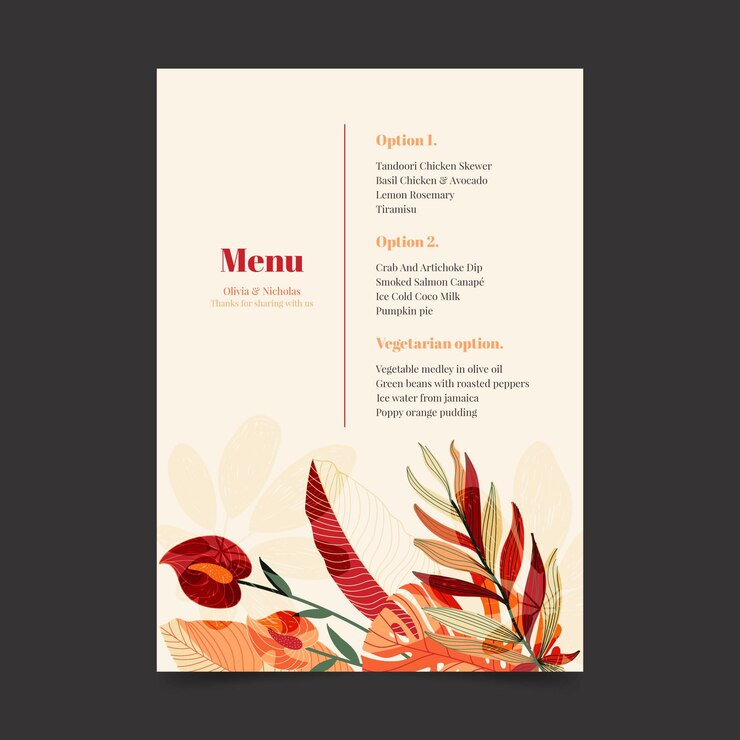Selecting the right catering menu for your event is very important, as it sets the tone for the entire occasion. The wrong menu choices can leave guests unsatisfied or feeling disconnected from the event’s theme, creating a less memorable experience. You might worry that the food won’t meet the diverse preferences of your guests or that the service style might not complement the event’s flow.
But with a thoughtful approach to your menu choices, considering factors like guest demographics, event type, and dietary needs, you can craft a dining experience that not only satisfies but also impresses you. Here’s how to ensure your catering menu becomes a standout feature of your event.
The Importance of Menu Planning in Event Success
The food served at an event is often what guests remember most, underscoring the importance of food in events. A well-thought-out menu can elevate the event, reflecting the theme, satisfying diverse palates, and contributing to the overall atmosphere. Whether it’s a wedding, corporate event, or private party, the catering menu options you choose play a pivotal role in creating a memorable experience.
Proper menu planning ensures that every dish complements the event’s style and guest expectations. For instance, food for corporate events might lean towards elegant, easy-to-eat options that allow for networking, while a wedding might focus on a more personalized and indulgent menu. The key is to align your menu choices with the event’s goals, ensuring that the food enhances the overall experience.
Choosing the Perfect Catering Menu
Understand Your Event Type and Theme
The first step in how to plan a catering menu is to consider the type of event you are hosting and its theme. For example, a formal dinner might require a sophisticated, multi-course meal, while a casual outdoor gathering could benefit from a BBQ or picnic-style spread. The catering food options should align with the event’s ambiance, whether it’s elegant, rustic, or modern.
Consider Your Guest Demographics
Understanding your guests’ preferences and dietary restrictions is crucial. Are there vegetarians, vegans, or guests with specific allergies? Ensure your catering menu options include something for everyone. This inclusivity not only satisfies your guests but also shows that you’ve thoughtfully considered their needs.
Incorporate Seasonal and Local Ingredients
Incorporating seasonal and locally sourced ingredients into your menu not only boosts the freshness and flavor of the dishes but also supports local farmers and producers. Seasonal ingredients are typically at their peak in quality and abundance, making them more cost-effective.
Additionally, a seasonal menu naturally aligns with the time of year, creating an ideal menu that feels relevant and thoughtfully curated for the occasion. This approach not only enhances the dining experience but also reflects a commitment to sustainability and local communities.
Balance Variety and Cohesion
While variety is essential in a catering menu, it’s equally important that the menu remains cohesive, ensuring that each dish complements the others. A well-rounded dining experience is achieved when the flavors, textures, and styles of the dishes harmonize, rather than compete. For instance, if your main course is rich and hearty, it’s wise to balance the meal with lighter appetizers and desserts.
This approach prevents guests from feeling overwhelmed by too many heavy dishes and allows each course to stand out while enhancing the overall meal. By thoughtfully curating your menu, you can create a seamless and enjoyable dining experience that leaves a lasting impression.
Choose the Right Service Style
When selecting the service style for your event, consider whether a buffet, plated service, or food station best fits your needs. Buffets are ideal for offering a wide variety of options and are convenient for casual or large gatherings. Plated dinners, on the other hand, provide a more formal and structured experience, often suited for elegant occasions.
Food stations introduce an interactive element, allowing guests to customize their meals and engage more deeply with the dining experience, making them perfect for events where guest interaction is a priority.
Common Mistakes to Avoid in Menu Selection
Ignoring Dietary Restrictions
One of the biggest mistakes in menu planning is neglecting to account for dietary needs. Failing to accommodate guests with allergies or specific dietary preferences can result in dissatisfaction and even health risks. To avoid this, it’s essential to include a variety of catering food options that cater to different requirements, such as vegetarian, vegan, gluten-free, and allergy-friendly dishes. By ensuring your menu is inclusive, you make all guests feel valued and cared for, contributing to a more successful event.
Overcomplicating the Menu
Although it may be tempting to provide an extensive menu, offering too many choices can overwhelm your guests and complicate the service. Instead, focus on a well-curated selection of dishes that emphasize quality over quantity. This approach not only makes it easier for guests to choose but also ensures that each dish is prepared and presented at its best. By prioritizing a few standout options, you can deliver a more refined and enjoyable dining experience.
Not Matching the Menu to the Event Timeline
The timing and duration of your event should play a crucial role in shaping your menu. For events that last several hours, it’s wise to provide lighter snacks or appetizers at intervals rather than relying on a single heavy meal. This approach keeps guests satisfied and energized without overwhelming them. Additionally, it ensures that the menu choices align with the event’s flow, allowing the dining experience to complement the overall schedule and atmosphere, keeping guests engaged and comfortable throughout.
Skipping the Tasting Session
Never skip the tasting session before finalizing your menu. This critical step allows you to evaluate the quality, presentation, and flavor of each dish, ensuring they meet your expectations. A tasting session provides the opportunity to experience the menu firsthand and make any necessary adjustments, helping you avoid surprises on the day of the event. By addressing any concerns or preferences during the tasting, you can confidently finalize a menu that will impress your guests.
Underestimating Portions
Making sure you have enough food is crucial to the success of your event, as running out can leave guests dissatisfied and hungry. It’s wise to err on the side of caution by providing slightly more than needed rather than risking a shortage. Collaborate closely with your caterer to determine appropriate portion sizes based on your guest count. This careful planning helps prevent any food shortages, ensuring that all guests are well-fed and satisfied throughout the event.
Tips for Creating a Memorable Dining Experience
Creating a memorable dining experience is about more than just serving great food; it’s about crafting an atmosphere that delights and engages your guests from the moment they arrive. Whether you’re planning a wedding, corporate event, or private gathering, here are some tips to ensure your dining experience leaves a lasting impression:
Curate a Cohesive Menu
The foundation of any memorable dining experience is a well-curated menu that aligns with your event’s theme and guest preferences. Ensure that each dish complements the others, balancing flavors, textures, and presentation. Offering a variety of dishes that cater to different dietary needs without overwhelming guests with too many choices is key to maintaining a cohesive and enjoyable meal.
Emphasize Fresh, High-Quality Ingredients
Using fresh, high-quality ingredients is essential for creating flavorful and appealing dishes. Whenever possible, incorporate seasonal and locally sourced ingredients to enhance the taste and presentation of your menu. Guests can often taste the difference, and it shows your commitment to providing the best dining experience.
Incorporate Interactive Elements
Interactive food stations or live cooking demonstrations add a unique and engaging element to your event. These features allow guests to customize their meals, watch skilled chefs in action, and create a more personalized dining experience. This interaction can be a highlight of the event, making it more memorable for your guests.
Focus on Presentation and Ambiance
The way food is presented plays a significant role in the dining experience. Pay attention to the visual appeal of your dishes, using creative plating techniques and attractive serving ware. Additionally, consider the overall ambiance of the dining area, including table settings, lighting, and décor, to create an inviting and cohesive atmosphere that enhances the meal.
Offer a Signature Drink or Dish
Introduce a signature drink or dish that reflects the event’s theme or the host’s personality. This unique offering can serve as a conversation starter and a memorable highlight of the dining experience. Whether it’s a custom cocktail, a special appetizer, or a themed dessert, a signature item adds a personal touch that guests will remember.
Create a Thoughtful Timeline
Ensure the dining experience flows smoothly by creating a thoughtful timeline that considers the pacing of courses, speeches, and activities. Avoid long gaps between courses, and coordinate the service with the overall schedule of the event. This helps maintain guests’ engagement and ensures they remain satisfied throughout the meal.
Incorporate Entertainment
Consider adding a touch of entertainment to the dining experience, such as live music, a themed performance, or interactive games. Entertainment can enhance the ambiance and keep guests entertained while they enjoy their meal, adding another layer to the overall experience.
FAQs
Can I customize my catering menu?
Yes, most caterers provide customizable catering menu options that can be tailored to your event’s theme and accommodate dietary needs. It’s important to discuss your preferences and any specific requirements during the initial consultation to create the ideal menu.
What if I have guests with dietary restrictions?
Make sure your catering food options include alternatives for guests with dietary restrictions, such as vegetarian, vegan, gluten-free, or allergy-friendly choices. Address these needs with your caterer early in the planning process to ensure everyone is accommodated.
How do I choose between a buffet and plated service?
The decision between a buffet and plated service depends on the formality of your event, your budget, and what your guests prefer. Buffets offer variety and are ideal for casual settings, while plated services are better suited for formal, structured events.
What should I consider when selecting a dessert?
When choosing a dessert, consider how it complements the overall menu and event. Light, refreshing options work well after a rich meal, while a dessert station adds variety and interactivity, engaging guests and enhancing the dining experience.
Conclusion
Choosing the perfect catering menu is essential to the success of your event. By thoughtfully considering the type of event, your guests’ needs, and the overall theme, you can craft a menu that both satisfies and delights. Avoid common pitfalls such as neglecting dietary restrictions or overcomplicating the menu, and ensure you collaborate closely with your caterer to finalize every detail. A well-planned menu goes beyond just the food—it creates an experience that leaves a lasting impression on your guests.
To ensure you’re making the best choices, it’s important to ask the right questions to your caterer, such as their experience with dietary restrictions, menu customization options, and how they handle setup and cleanup. If you’re hosting an event in California, consider exploring catering services in Santa Cruz for exceptional options that deliver quality and professionalism. With the right planning and expert guidance, your catering menu will be a standout feature of your event.





